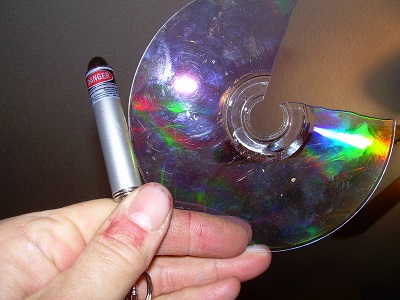Final
Project


Preliminary research has been completed using a $2.00
laser pointer that may be used for
a microscope and a split CD thay
may provide material for a spectrometer.
Citizen Scientist Toolkit
A science kit containing basic instruments that K-12 students can use to explore the world around them will be developed. The kit will allow for:
- K-12 students to explore the natural world
- In-service training for
K-12 teachers (note that the project can go beyond
STEM and include topics such as the history of the
microscope, geography related to area being studied,
art including technical illustration and
self-expression and the like).
- Examples or pre-service teachers to use to develop and design curriculum and hone teaching skills by delivering related lessons.
- Pre-service teacher training in Fab Lab -related activities
- Springboard for grant opportunities.
- Connect to citizen scientist initiatives locally and globally.
Items to be considered as
part of the kit may include:
- microscope (may or may not need light)
- ph balance test kit
- temperature sensor
- ph meter
- dissolved oxygen sensor
- water turbidity gauge
- phosphorus tester (if possible).
- camera (if possible)
- container for holding
various components
What will it do?
- K-12 students to explore the natural world around them
- form the basis for summer
camps for K-12 students.
- provide in-service training for STEM teachers
- provide examples for pre-service teachers to use to develop and design curriculum and hone teaching skills by delivering related lessons.
- allow pre-service teacher training in Fab Lab -related activities
- springboard grant opportunities.
- provide discussion points for educational communities interested in Fab Labs.
- connect to citizen scientist initiatives locally and globally.
- inspire innovation.
Who's done what beforehand?
Information on sensors can be found at
Smart Citizen - Sensors at http://goteo.org/project/smart-citizen-sensores-ciudadanos
Building the Simplest Possible ph Meter http://www.66pacific.com/ph/simplest_ph.aspx
How to Make a Homemade Ph meter http://www.ehow.com/how_7778032_make-homemade-ph-meter.html
Information on building microscopes can be found at
YouTube - DIY Mini Microscope http://www.youtube.com/watch?v=eLR5Cn6sB9M
Fun Science Gallery at http://www.funsci.com/fun3_en/ucomp1/ucomp1.htm
NASA's Optic Educator Guide found at http://www.nasa.gov/audience/foreducators/topnav/materials/listbytype/Building_a_Microscope.html
How to build a microscope from laser cut parts http://www.youtube.com/watch?v=fs4r2dtfWE0
Build a Microscope from Instrutables http://www.instructables.com/id/Build-a-microscope!/
Matchbox microscope http://www.ehow.com/how_5043105_build-microscope.html
What
materials and components will be required?
Fabric, resin, Ooh Moo, camera chip, various sensors, electrical components as per Fab Lab inventory, machinable wax, ph sensors, lenses for microscope (under $1/each), temperature sensor.
Where will
they come from
I will either make the sensors if possible and buy what is needed from Digikey or other supplier.
More common items such as acrylic, press board, fabric and so forth will come from Menards lumber supply, Walmart, or other local and inexpensive suppliers.
Microscope parts
Sensors
Final container
What
processes will be used?
Laser cutter for microscope and perhaps final container
CNC mill possible for final container - either cut out actual container or mill mold
Modela mill - circuit board construction and molds for microscope parts
CAD - model parts for microscope and perhaps sensor housings
Programming - sensors and inputs/outputs as indicated
Vinyl cutter - for microscope slides
Composites - tentatively used for microscope body and final container
Determine cost
Determine instrument/sensor sizes - there is information for small and medium sized instruments. I need to consider cost, durability, functional use, ease of construction (particularly if directions are distribution to K-12 schools as projects for students to make), and material procurement amont others.
A: Microscope (may or may not need light), ph balance test kit, temperature sensor, ph meter, dissolved oxygen sensor, water turbidity gauge, phosphorus tester (if possible).
May 15 -22 Continue researching sensor building. Order parts and start building sensors and equipment. Start programming sensors.
May 22-29 Build final container and finish programming.
Computer- Aided Design
You need to design the
project on a computer.
Physical Design &
Fabrication (usage of the Fab Lab equipment)
The more machines and
processes you use in your final project, the better,
but you need to include AT LEAST ONE ASPECT of
physical design and fabrication using the machines we
covered in class.
- 3D scanning and printing
- molding and casting (Modela / ShopBot + molding and casting materials)
- composites
- computer controlled machining (ShopBot)
- computer controlled cutting (vinyl & laser cutters)
Embedded Programming
- You need to program your project yourself and / or modify some example code.
- The modified example code can come from anywhere and be in any programming language.
Input & Output
Devices
You should incorporate
both an input AND an output device into your
project.
Electronics Design and
Production.
You should fabricate the
electronics yourself.
Other possible areas that
may be incorporated (NOT REQUIRED):
- Interface and application programming
- Networking and communications
- Machine / mechanical design